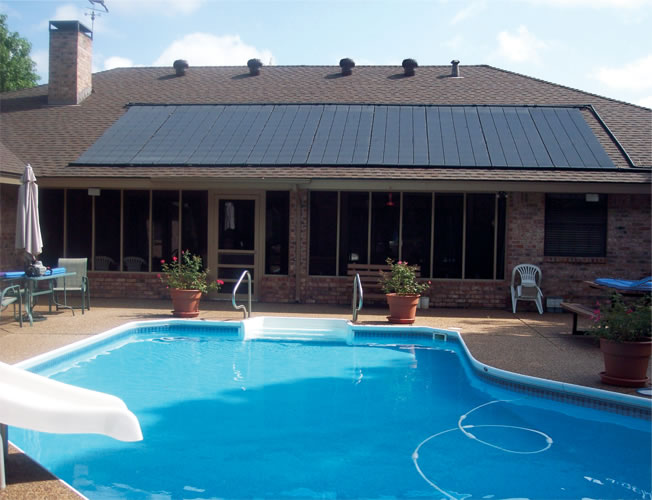Homeowners can substantially decrease the overall expense to heat their swimming pools by installing solar pool heating. Not only are they cost competitive with both heat pump and gas pool heaters, they have extremely low yearly operating costs as well. Overall, heating a pool through the use of solar is a very cost-effective way to use solar energy in various climates.
How Solar Works to Heat Pools
The majority of solar pool heating systems consist of the following:
• Solar Collector
The device that pool water circulates through in order to be warmed by the sun
• Pump
The pump is used to circulate water directly through both the filter and collector and then back into the pool
• Filter
The filter works to eliminate debris before the water is subsequently pumped through the solar collector
• Flow Control Valve
Manual or automatic device that redirects pool water through the collector
Pool water pumps through the filter before it’s directed to the collector, where it’s then heated prior to returning to the pool. In warmer climates, the solar collector can also be used to cool down the temperature of the pool during hot summer months by effectively circulating the pool water through the solar collector at night.
Some solar heating pool systems come with sensors and a manual or automatic valve to redirect water through the solar collector when the temperature of the collector is adequately higher than the temperature of the pool. Once the temperature of the collector is similar to the pool’s temperature, the filtered water will just bypass the collector and return back to the pool.
Solar Pool Collectors
Solar Pool Collectors are generally made from a variety of materials. The kind you’ll need will greatly depend on your particular climate and exactly how you intend to use it. For instance, if you’re only going to use your pool if the temperature is above freezing, then you’ll likely only require an unglazed collector system. Keep in mind that unglazed solar collectors do not have a glass covering, or glazing. They are commonly made from heavy-duty rubber or strong plastic that’s treated with an UV (ultraviolet) light inhibitor in order to extend the overall life of the panels. Due to their simple design and low-cost parts, unglazed solar collectors are typically cheaper than glazed solar collectors. If the system itself is designed to drain directly back to the pool if it’s not in use, the unglazed systems are adequate for indoor pools as well.
Choosing an Ideal Solar Pool Heater
These systems typically cost anywhere between $3,000 – $4,000 to purchase and install. Usually, they last considerably longer than heat pumps or gas water heaters as well. Your literal cost and payback will depend on a number of factors. And so, prior to purchasing and installing your system, you should ideally do the following first:
• Establish the right orientation as well as tilt for the solar collector
• Establish the efficiency of the system
• Establish the correct size for the system
• Compare various system costs
• Assess your site’s solar resource
• Explore local codes, regulations, and covenants
Properly Assessing Your Site’s Solar Resource
Before you purchase and install your system, you’ll first need to determine your site’s solar resource. The design and efficiency of a solar pool heater primarily depends on how much radiant heat from the sun is able to reach your building site. Overall, if your key building site has sunny areas and basically faces the south, then it’s likely an ideal spot to install a system in order to adequately heat your pool.

